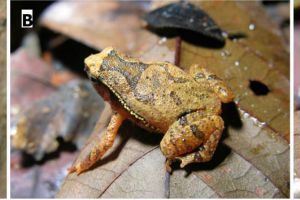
Frogs of Borneo

Frogs of Borneo

Frogs of Borneo

Frogs of Borneo

Frogs of Borneo

Frogs of Borneo

Frogs of Borneo

Frogs of Borneo

Frogs of Borneo

Frogs of Borneo

Frogs of Borneo
minutus
Small Crocker Sticky Frog
Kalophrynus minutus was originally described from Crocker Range National Park, Sabah, Malaysia (Imbun et al. 2025). The species has been documented from elevations between 1200 and 1216 m a.s.l., i.e., from lower montane tropical forest.
This is a small species of Kalophrynus. The adults are less than < 25 mm in snout–vent length, specifically 18–21 mm in males, 21–24 mm in females.
The fourth finger possesses only a single subarticular tubercle. The free portion of the fourth finger is less than the length of the terminal phalanx of the third finger. The fifth toe is shorter than the third.
The upper body is tan to beige, with its appearance varying depending on environmental conditions. The underside is lighter than the dorsum. Overall, the species is well camouflaged, closely resembling dead leaves and blending effectively into the leaf litter. A thick, X-shaped marking of darker pigmentation is present across the shoulders. Along the sides, a conspicuous dorsolateral row of white tubercles edged in black is visible. The throat usually bears an irregular pair of dark longitudinal bands. The chest and abdomen are marked with small, irregular black spots or dots, while the ventral surfaces of the limbs have a few scattered black dots. As prominent features, a large black inguinal blotch is present and the posterior faces of the thighs is with or without one to four black rimmed light spots.
Kalophrynus minutus is a small terrestrial, partly sub-fossorial frog that inhabits the forest floor, where it rests on dead leaves or soft soil. Its minute size and cryptic, leaf-litter coloration make it difficult to detect, yet several individuals were encountered during each survey by the team in Imbun et al. 2025. At the type locality, the species was consistently found away from ponds, streams, or other bodies of water. To date, neither eggs nor tadpoles of this species have been documented. However, non-feeding tadpoles of other Kalophrynus species have been discovered in phytotelmata and such a reproductive mode or direct development may apply to K. minutus as well.
The photo panel (© Paul Imbun) presented here was copied from the original publication under a creative commons license.
Version tracking
-
26.09.2025
page created
